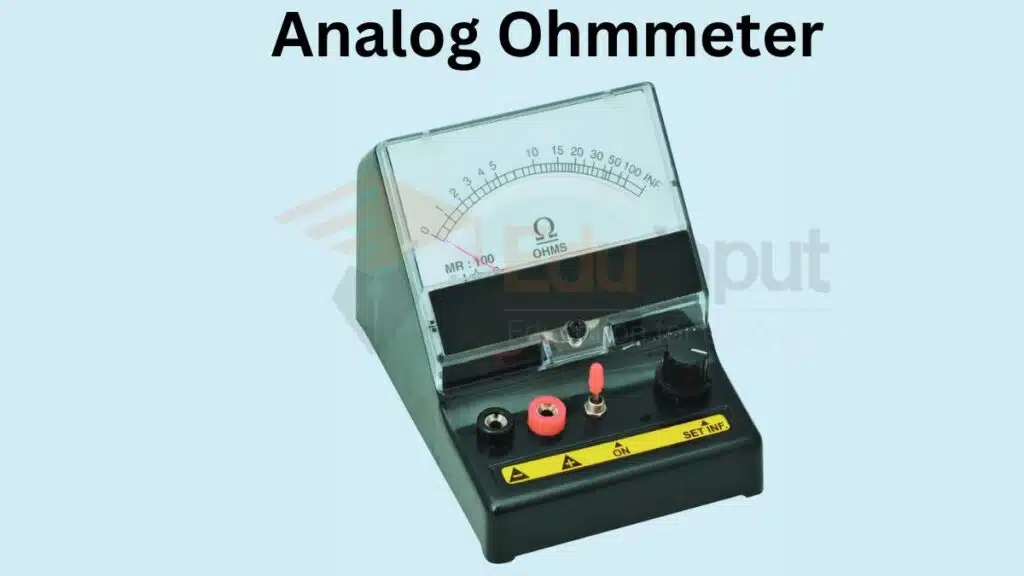Analog Ohmmeter-Definition, Working, And Advantages
An analog ohmmeter is an electrical instrument that measures resistance in electrical circuits. Unlike digital ohmmeters that display resistance values on a screen, analog ohmmeters rely on the deflection of a pointer on a scale to indicate the measured resistance.
What is an Analog Ohmmeter?
Analog ohmmeter also known as analog multimeter is a versatile tool that allows technicians and enthusiasts to measure resistance with ease. It is a type of ohmmeter. It consists of a moving needle or pointer, a scale, and various settings to adjust the sensitivity and range of measurement.

While digital ohmmeters offer precise numerical readings, analog ohmmeters continue to hold their ground as trustworthy instruments in the field.
Working Principle of Ohmmeter
Analog ohmmeters operate based on the principle of measuring current flow through a known resistance. When the test leads of an analog ohmmeter are connected across a resistor, a small current flows through the resistor and the internal coil of the instrument. The magnitude of this current is directly proportional to the resistance being measured.
Analog ohmmeters consist of several key components. The main components include a battery or power source, a precision resistor known as the “shunt,” a coil wound with fine wire, and a moving pointer or needle. The shunt and coil are connected in series with the test leads.
Advantages of Analog Ohmmeters
These are some advantages of using an analog ohmmeter.
Simplicity and Ease of Use
Analog ohmmeters are praised for their simplicity and user-friendly nature. They don’t require any power source other than the internal battery, making them portable and easy to handle. Their straightforward operation allows even beginners to quickly grasp how to use them for resistance measurements.
Durability and Reliability
Analog ohmmeters are known for their robust construction and durability. They are designed to withstand rough handling and harsh working environments. These instruments can endure accidental drops and voltage surges, ensuring reliability in various electrical testing scenarios.
Limitations of Analog Ohmmeters
There are also some limitations to using an ohmmeter.
Limited Measurement Range
One significant limitation of analog ohmmeters is their limited measurement range. Different models may have varying measurement ranges but typically cover resistance values from a few ohms to a few megaohms. If you need to measure extremely low or high resistances, you might require additional specialized instruments.
Accuracy and Precision
Analog ohmmeters have inherent limitations when it comes to accuracy and precision. The accuracy of analog meters is influenced by factors such as the quality of internal components, calibration, and temperature variations. These instruments may also be susceptible to parallax errors caused by misalignment of the pointer and the scale, affecting measurement accuracy.
Applications of Analog Ohmmeters
Electrical Circuit Testing
Analog ohmmeters find wide application in electrical circuit testing. They allow technicians to quickly check the continuity of wires, connections, and components. By measuring the resistance of various elements within a circuit, analog ohmmeters can help identify faulty components or wiring issues.
Troubleshooting and Maintenance
Analog ohmmeters are indispensable tools for troubleshooting and maintenance tasks. They can assist in locating short circuits, open circuits, and faulty components in complex electrical systems. Technicians can use these instruments to track down problems and perform necessary repairs efficiently.
Digital Ohmmeters vs. Analog Ohmmeters
Differences and Features
Digital ohmmeters, unlike their analog counterparts, display resistance values directly on a digital screen. This feature provides precise numerical readings, eliminating potential errors caused by human interpretation. Analog ohmmeters, on the other hand, rely on visual interpretation of the needle’s position on the scale.
Choosing the Right Ohmmeter
The choice between digital and analog ohmmeters depends on various factors. Digital ohmmeters are generally preferred for high-precision measurements and when precise numerical values are necessary. Analog ohmmeters, with their simplicity and durability, are often favored for quick checks, fieldwork, and environments where ruggedness is essential.
Tips for Using an Analog Ohmmeter
Precautions and Safety Measures
When using an analog ohmmeter, certain precautions must be taken to ensure accurate measurements and personal safety. It is essential to avoid measuring resistance in live circuits to prevent potential electrical hazards. Always disconnect the circuit from the power source and discharge any capacitors before making resistance measurements.
Correct Usage Techniques
To obtain accurate measurements with an analog ohmmeter, ensure proper contact and connections. Clean the test leads and the contact points to minimize contact resistance. Use the appropriate range setting and adjust the sensitivity of the instrument according to the expected resistance value. Avoid excessive movement or jarring of the instrument during measurements.
Related FAQs
Can we measure resistance in live circuits using an analog ohmmeter?
No, it is not safe to measure resistance in live circuits using an analog ohmmeter. Always disconnect the circuit from the power source and ensure capacitors are discharged before making any resistance measurements.
Can we use an analog ohmmeter to measure capacitors and inductors?
No, Analog ohmmeters are primarily designed for measuring resistance. They are not suitable for directly measuring capacitors or inductors. For these components, specialized instruments such as capacitance meters or inductance meters should be used.
Are analog ohmmeters suitable for precision measurements?
Analog ohmmeters have limitations in terms of accuracy and precision compared to digital instruments. If precise numerical readings are required, digital ohmmeters are a better choice. However, analog ohmmeters are still reliable for general resistance measurements and quick checks.







Leave a Reply